Description
Canada’s artillery systems play a crucial role in the country’s defense capabilities, providing long-range firepower, precision strike capabilities, and indirect fire support for ground forces. These systems are integral components of the Canadian Armed Forces, enhancing their ability to operate effectively in various operational scenarios, including combat missions, peacekeeping operations, and humanitarian assistance.
Artillery systems encompass a wide range of weapons, from towed howitzers to self-propelled artillery and rocket systems. These platforms are designed to deliver various types of projectiles, including high-explosive rounds, precision-guided munitions, smoke rounds, and illumination rounds.
The Canadian Armed Forces deploy a variety of artillery systems to meet different mission requirements. Towed howitzers, such as the M777, are lightweight and highly mobile, providing infantry units with rapid and responsive fire support in various terrain conditions.
These towed systems are transportable by air and can be quickly deployed to remote areas, supporting expeditionary operations and enhancing the Canadian Armed Forces’ ability to respond to emerging threats.
Self-propelled artillery, like the M109A7 Paladin, offers enhanced mobility and firepower. These vehicles are equipped with a turret-mounted howitzer and can operate independently or as part of a larger artillery battery.
Self-propelled artillery provides a higher rate of fire and greater tactical flexibility compared to towed systems, making it a critical asset in modern ground operations.
Canada’s artillery systems are also equipped with precision-guided munitions, such as the M982 Excalibur, which revolutionizes artillery warfare. These munitions utilize GPS guidance to achieve pinpoint accuracy, minimizing collateral damage and increasing the effectiveness of each engagement.
The deployment of precision-guided munitions significantly enhances the Canadian Armed Forces’ ability to engage high-value targets with accuracy and precision, contributing to the success of ground operations.
Furthermore, artillery systems play a crucial role in providing indirect fire support to ground forces during combat missions. These systems can engage targets beyond the line of sight, providing cover for advancing troops and suppressing enemy positions.
Artillery support is essential in offensive operations, allowing ground forces to gain a tactical advantage and penetrate enemy defenses effectively.
In addition to combat missions, artillery systems are instrumental in supporting peacekeeping and stabilization efforts. They can provide fire support during peacekeeping operations and assist in maintaining a secure environment in conflict-affected areas.
Moreover, artillery systems can be deployed for humanitarian assistance and disaster relief operations. They can deliver humanitarian aid and supplies to affected populations or assist in search and rescue missions.
The Canadian Armed Forces prioritize comprehensive training programs for personnel operating artillery systems. Training includes gunnery skills, tactical maneuvers, and coordination with ground forces to ensure that artillery units can effectively integrate with other military assets during operations.
Furthermore, the Canadian government invests in ongoing research, development, and modernization of its artillery systems. These investments aim to improve the mobility, range, accuracy, and lethality of artillery platforms, ensuring that they remain technologically advanced and capable of addressing evolving threats on the battlefield.
Canada’s defense industry plays a crucial role in the development and integration of advanced artillery systems. Domestic defense companies collaborate with the Canadian Armed Forces to develop cutting-edge technologies and enhance the country’s artillery capabilities.
Additionally, international collaboration and participation in multinational exercises and operations enable Canada to learn from its allies and integrate best practices into its artillery operations.
Canada’s artillery systems adhere to strict adherence to international laws and protocols governing arms control and the use of military weapons. The Canadian government maintains robust export control mechanisms to prevent unauthorized proliferation of advanced artillery systems and related technologies.
As Canada’s security environment continues to evolve, the Canadian Armed Forces will continue to invest in advancing its artillery capabilities to maintain its position as a capable and agile military force.
In conclusion, Canada’s artillery systems are essential assets in the country’s defense capabilities, providing long-range firepower, precision strike capabilities, and indirect fire support for ground forces.
Deployed in various configurations, including towed and self-propelled artillery, these systems are highly mobile and adaptable to different operational scenarios, supporting combat missions, peacekeeping operations, and humanitarian assistance.
Canada’s commitment to training and readiness ensures that personnel operating artillery systems are proficient and can effectively integrate with other military assets.
Ongoing research and development, collaboration with the defense industry and international partners, and adherence to international arms control regulations underscore Canada’s dedication to maintaining technologically advanced and responsible artillery capabilities.
As Canada’s security requirements continue to evolve, the Canadian Armed Forces will undoubtedly continue to invest in advancing its artillery capabilities to remain a potent and effective force in the face of emerging threats and security challenges.




